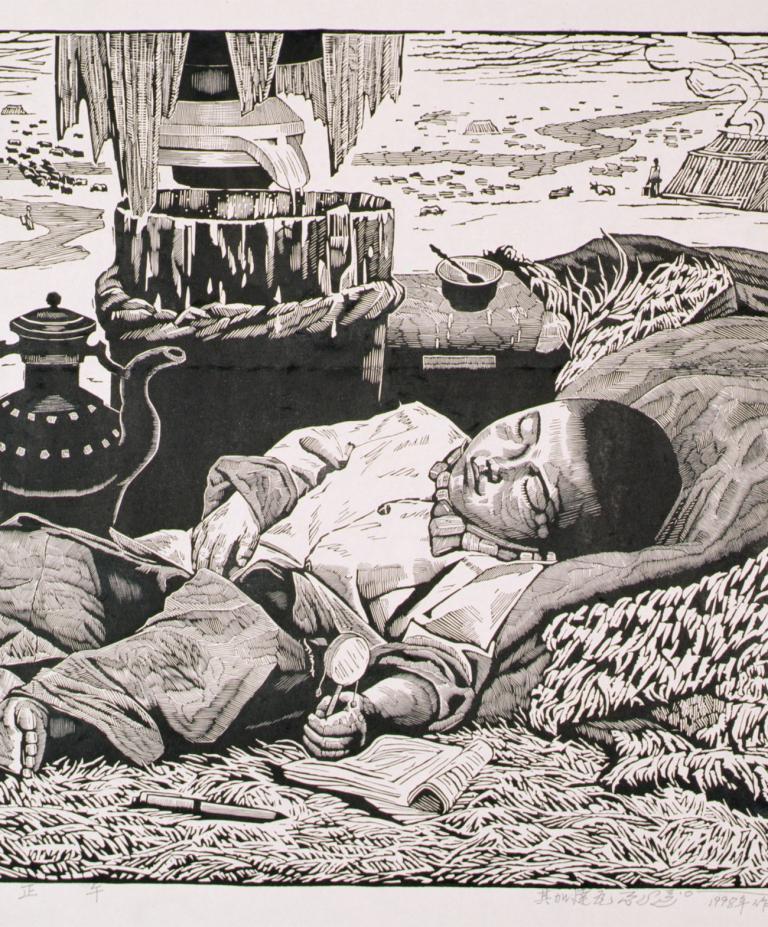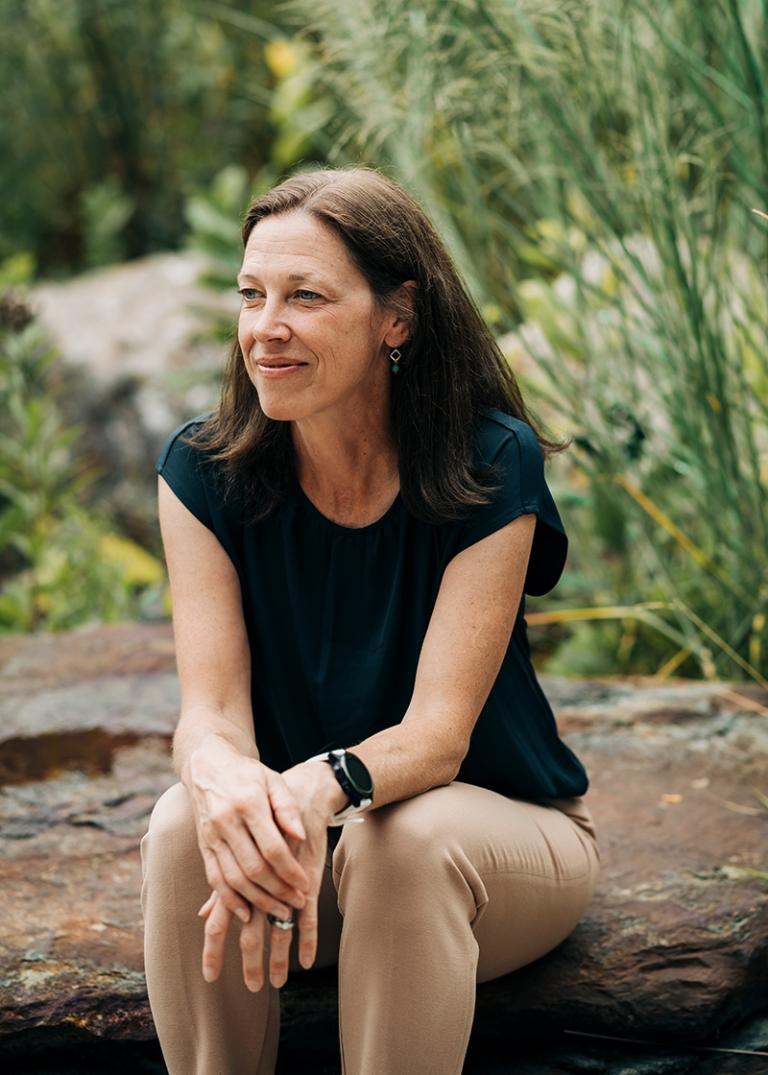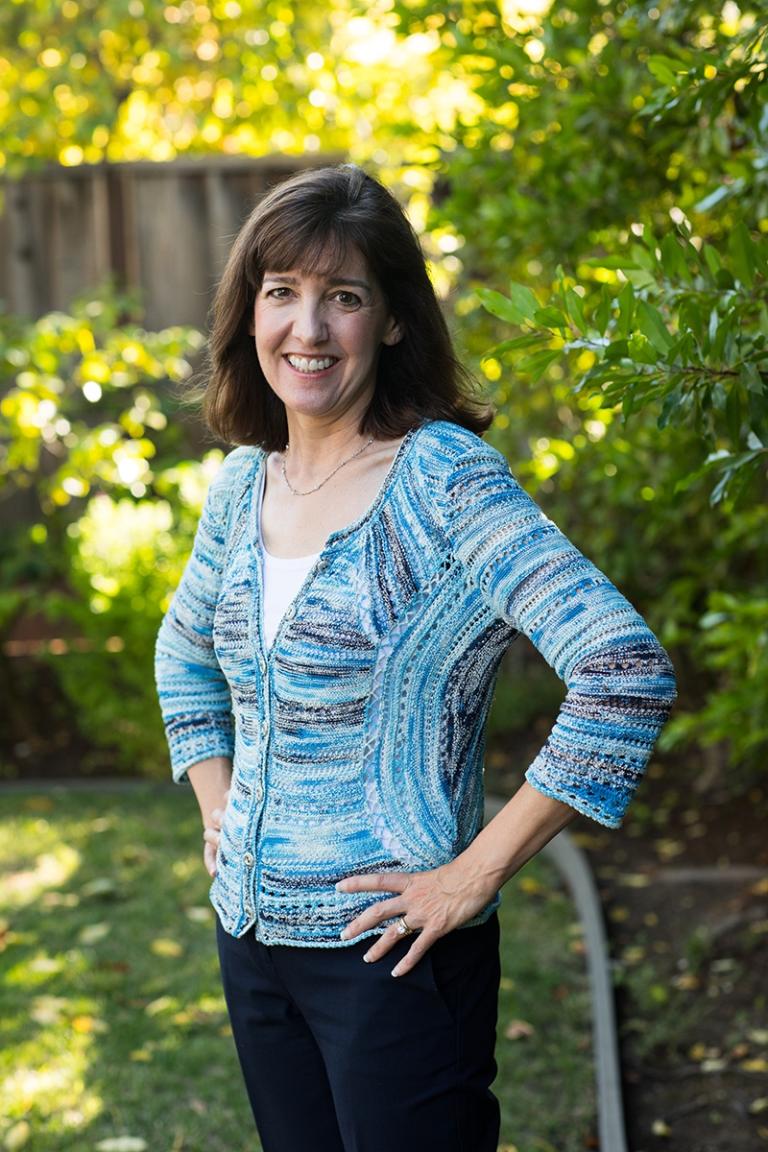A Child’s Need for Sleep
A good deal of a child’s brain growth and development occur during sleep
- 12 minute read
- Feature
Qijia Dawa (b. 1946) Midday (Zhengwu) Woodcut 1998

Qijia Dawa (b. 1946) Midday (Zhengwu) Woodcut 1998
“Hey parents! Tired of those out-of-control kids, throwing embarrassing tantrums wherever they go?” starts a YouTube parody video. “You’ve had it with parenting,” the infomercial-style voiceover exclaims as a fed-up mother shakes her head. “But wait! There is a solution! Introducing Naptime! — the latest, most effective tool for child-tantrum prevention!” Cut to scenes of bedraggled parents instantly quieting their children with a few sprays from a bottle full of the fictional product.
With almost 26 million views, the video, written and directed by the cheeky Brooklyn-based producer Chris Capel, has clearly struck a chord. But to millions of parents, naptime is no joke.
“It’s always been one of the huge core issues for people living with infants, toddlers, and small children,” says Perri Klass, MD ’86, a pediatrician and the author, most recently, of The Best Medicine: How Science and Public Health Gave Children a Future. “We go through different cultural moments in terms of where our major anxieties are, but sleep training and sleeping through the night versus daytime napping are a constant.”
According to Matthew Walker, a professor of neuroscience and psychology at the University of California, Berkeley, and author of Why We Sleep: Unlocking the Power of Sleep and Dreams, preindustrial societies in Western Europe, Africa, the Middle East, South Asia, and Latin America arranged their routines around biphasic sleeping. In some regions, people began their “first sleep” when the sun set, waking during the night to read, write, pray, socialize, or have sex and squeezing in a “second sleep” in the hours before chores beckoned at dawn. But Walker writes that this sleep pattern was likely a cultural phenomenon. More often, he writes, “the true pattern of biphasic sleep — for which there is anthropological, biological, and genetic evidence … is one consisting of a longer bout of continuous sleep at night, followed by a shorter midafternoon nap.” Because of this behavior, children’s sleep patterns were not seen as significantly different from those of grown-ups, with little ones presumably fulfilling their need for two to ten additional hours a day, depending upon their age, however and whenever they could.
We go through different cultural moments in terms of where our major anxieties are, but sleep training and sleeping through the night versus daytime napping are a constant.
Once factory work came along in the late 1700s, adult schedules began to become more regimented and children’s sleep patterns followed suit. In the years since, advice on child-rearing has become an industry, and scientists have learned more about how much sleep children really need, when they need it, which sleep pattern is best, and what happens to young brains during sleep.
Much is still unknown, but it has become clear that sleep is essential to learning, memory formation, emotional regulation, and physical and mental development and that naps are an essential part of a child’s health and well-being.
Sleepy heads
Children need a lot of sleep — up to 17 hours a day for infants under three months to 10 hours per night for 18-year-olds, according to the U.S. Centers for Disease Control and Prevention.
While naps count toward total sleep necessary at any age, they play a special role for young children because of the interaction of their circadian rhythms and the homeostatic process known as sleep pressure, or, in lay terms, tiredness. Scientists still aren’t sure why sleep pressure builds more quickly in children than adults, but some suggest it’s because they usually can’t get 13 or 14 hours of uninterrupted sleep, in part because they must eat frequently, and they need naps to make up for the sleep they don’t get at night.

But there’s more to it than simply getting enough sleep in a 24-hour cycle. Numerous studies have shown that napping clears the brain — specifically the hippocampus, a seahorse-shaped structure in each hemisphere that plays an important role in learning and memory — so that it can be filled again with new information. Rebecca Spencer, a professor of cognitive neuroscience at the University of Massachusetts Amherst, describes the hippocampus as a short-term filing system.
“All the new things you encounter in a day get thrown in there before being sorted into the cortex — which is a bigger, long-term filing system that can sort things by type — during sleep,” she says. “So if you learn grandma used to be a ballerina and you already know she likes to knit, then those two things are integrated into your concept of grandma, which helps you create generalities and also makes each memory easier to find. Kids are constantly bombarded with new information. They’re not only learning their alphabet, for example, but also that the sky is blue and bunnies are furry — things that adult brains take for granted — so we think their hippocampus just needs to be cleaned out more often.”
Spencer’s research has found that children who nap soon after learning new words, for example, remember the words 80 percent of the time, as opposed to 30 percent for those who don’t nap. Children who don’t nap also score an average of 10 percent lower on word retention tests compared to children who do nap. What surprised Spencer, though, was that the ability to remember what was learned continued into the next day. “What that tells us is that sleep has to take place shortly after learning for the learning to take root,” she says.
All the new things you encounter in a day get thrown in the hippocampus before being sorted into the cortex during sleep.
Emotional memory and reactivity are affected by naps in basically the same way, as any parent confronted by a grumpy toddler knows. “Kids are exposed to emotional scenarios all morning long,” says Spencer, “at the level of ‘mom made me put my shoes on and I didn’t want to,’ or ‘I didn’t get my favorite food for breakfast.’ Our studies show that if they take a nap, they’re cool as a cucumber. It gives them a clean slate when they wake up because all the emotional memories from the morning are cleaned out. So if they see a classmate acting up in the corner, they’re less bothered by it. If there’s no nap, the emotional load is never released, and they may overreact too.”
Mind and body
Not getting their naps can cause big problems for little kids. “We see attention issues, emotional disruption, academic difficulties, mental health problems, weight gain, even changes in growth,” says Laura De Girolami, MD ’05, a Brookline pediatrician who says she discusses sleep with parents every time they come for a visit. Almost all human growth hormone is produced during slow-wave, or deep sleep, which a 45-minute nap is long enough to produce. “Lack of sleep can result in decreased growth hormone secretion and cortisol levels,” De Girolami adds. “I generally don’t tell parents that because it will completely freak them out, and the problem is usually temporary.” Children whose sleep routines are disrupted because of illness, according to Spencer, will often experience a growth spurt once they recover their normal sleeping regimen.
Kids who are already at increased risk for challenging social behaviors may have a harder time sleeping, which can then create a vicious cycle resulting in more challenging behaviors. And that’s true not just for younger kids. While children mature at different rates, most grow out of the need for a nap by around age 5, but now “we live in such a sleep-deprived culture that naps can be beneficial longer,” says Denise Clark Pope, a senior lecturer at Stanford’s Graduate School of Education and an alumna of Harvard’s Graduate School of Education. In 2001, Pope authored Doing School: How We Are Creating a Generation of Stressed-Out, Materialistic, and Miseducated Students.

A paper presented at the American Academy of Pediatrics (AAP) 2019 conference found that only about half of U.S. children aged 6 to 17 are getting enough sleep and that those who aren’t are deficient in measures of “childhood flourishing,” such as showing curiosity about new things, caring about their schoolwork, staying calm when faced with a challenge, and finishing tasks they’d begun.
Research published in Lancet Child & Adolescent Health in July bears this out and highlights the neurological outcomes of insufficient sleep. The analysis drew on data from the NIH’s ongoing Adolescent Brain Cognitive Development study, looking at more than 8,000 9- and 10-year-olds, about half of whom got less than nine hours of sleep a night. The sleep-deprived children had more mental health and behavioral issues than their peers who slept nine or more hours a night and were more likely to be depressed, anxious, and aggressive. Furthermore, brain imaging showed that the less-rested children had a smaller volume of gray matter in the areas of the brain responsible for attention, memory, and inhibition control. And these neurological deficits didn’t diminish quickly; the researchers found that the lower volumes were still evident two years after the initial evaluation.
A 2018 CDC study found that up to 73 percent of high schoolers are getting too little sleep. “In older kids, we know that when this happens bullying goes up,” says Pope, “their abilities to self-regulate and to make decisions become impaired, and their metabolism is affected.” One study Pope conducted with more than 135,000 students found that about 20 percent of teens slept an average of five hours or less at night — about half of the eight to ten hours recommended by the AAP. On top of the problems already noted, this may help explain the spike in ADHD diagnoses since the late 1990s, Spencer notes. “Sleep can improve inhibitory control,” she says, “and that’s the core deficit in kids with ADHD: they lack inhibitory control and sustained attention. Kids with ADHD generally need 45 minutes more sleep to get the same benefit as typically developing kids. So if we find underlying sleep apnea, for example, once that’s treated, ADHD-like behaviors will decrease significantly.”
Lights out
That coffee shops are now on every corner and energy drink companies are marketing to teens only exacerbates the issue, doctors say, as, of course, does electronic media. “Young people have poorer impulse control,” says De Girolami. “Adults might not respond to a text because they know it can wait, but kids don’t feel that way. Especially with apps like Snapchat, where the text is only there for twenty-four hours, and their friends saying, ‘Why didn’t you open my Snap right away? Why didn’t you Snap back?’ This teenage phenomenon of immediacy means you can never get a screen break so your mind can quiet down.”
A 2019 survey by the nonprofit Common Sense Media found that almost a third of teens sleep with their phones in their beds, and a review of twenty studies published in JAMA Pediatrics in 2016 found that use of mobile devices after lights-out was associated with less sleep and poorer sleep quality.
“There’s a reason you’re supposed to dim the lights an hour or so before bed,” says Pope, “never mind not looking at your phone. Light suppresses the release of melatonin, which helps induce sleep by calming the brain. But for young people now, checking their phones is Pavlovian.”
Family situations can sometimes disrupt sleep as well, says Klass. “Most physicians are aware that inequities can play out in all kinds of ways both subtle and unsubtle,” she says. “Sleep patterns don’t happen in a vacuum. Is there a quiet place for the child to sleep during relevant hours? It could be way different if the family is in a shelter or renting a single room in someone’s house, or if the parents work nights. I think we’re more aware of these things than we used to be, but we’re probably never sufficiently aware of them.”
Kids are sitting for hours on end these days — on buses, in class, maybe at their jobs. The body needs to be active to have better sleep.
Pediatric sleep specialists sometimes recommend certain medications to help children with neurodevelopmental disorders fall asleep and stay asleep, or, for neurotypical kids, melatonin for a short period until they return to regular sleep schedules after a disruption, but most experts prefer the use of natural methods whenever possible.
Young children can sometimes be lulled to sleep at naptime by a caregiver placing a hand on their back, rubbing their feet, or simply sitting beside them, because, as Spencer points out, if they know they’re being watched they’re more likely to settle down. De Girolami actually recommends against naps for teens because they can “just keep the cycle of sleep imbalance going.” Instead, she suggests older kids learn to practice better sleep hygiene, perhaps by meditating, having a bath before bedtime, or sipping chamomile tea. “It’s essentially about having a ritual to cue your body it’s time for bed,” she says. Exercise, too, can make a big difference. “Kids are sitting for hours on end these days — on buses, in class, maybe at their jobs,” says Pope. “The body needs to be active to have better sleep, even though it can seem counterintuitive.”
Parents, these physicians agree, are often yearning for the one right answer, and, as with so many health matters, there simply isn’t one. “Children are really different temperamentally and in terms of patterns,” says Klass. “Anybody who’s had more than one child knows this. You may have an easy kid, a hard kid, a good sleeper who happily naps whenever and wakes up smiling, or one who’s harder to put down and harder to wake up. It’s important not to look at this as a one-size-fits-all situation and to give parents the sense that they’re doing something wrong. Some parents just have a harder assignment.”
Elizabeth Gehrman is a Boston-based writer.
Images: Private collection © Paul Freeman/Bridgeman Images (top); Isabella Dell’olio (Spencer); Elisabeth Fall (Pope)
Continued funding uncertainty jeopardizes promising HMS research advances.